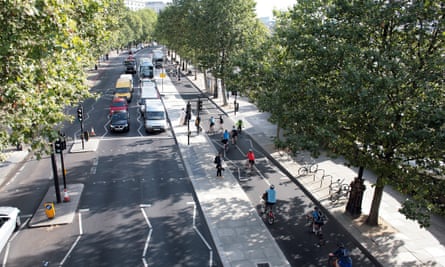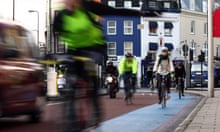Juliet Samuel is a regular columnist for the Telegraph, who opines authoritatively about politics, society and business. And yet last month she wrote something which was very obviously incorrect.
Something needed to be done, Samuel said, about the “epidemic of bike lanes taking over otherwise useable roads all across London”. She continued:
I cycle and drive, but these lanes go far beyond the measures needed to improve safety and instead just make it almost unbearable to get in a car. It takes a minimum of one hour to get out of town, half of which is spent churning out extra exhaust as you sit on clogged roads and roundabouts that were flowing perfectly well until now.
Even if you ignore the idea that London’s roads used to flow “perfectly well” (perhaps all Samuel’s previous London driving and cycling took place at 5am on Sundays), there is a very obvious error here.
It’s the peculiarly tenacious, if easily disproved myth that building separated cycle lanes causes greater traffic congestion, and thus more pollution.
In Samuel’s very minor defence, she is merely repeating what she has probably read elsewhere. The previous month, James Salmon, the Daily Mail’s transport correspondent, wrote a hugely odd story noting that Cambridge and London had among the slowest average traffic speeds in the country.
The paper put this down largely to cycle lanes, despite the fact other places in the list included Wolverhampton and Hereford, neither of which are known for their Dutch-style levels of cycling infrastructure. (As if in unconscious acknowledgment of the article’s essential absurdity, the story was illustrated with a photo of a bike lane in Cambridge, Massachusetts.)
Unbowed, the Mail used a story last month about the College of Paramedics raising concerns about separated bike lanes (a story that, it is worth noting, misquoted the college’s views) in an editorial column:
Segregated cycle lanes have increased congestion and worsened pollution ... Isn’t it time to abandon this cycle ‘superhighway’ experiment and admit that it was a stupid mistake?

There are two elements to unpick this statement: firstly to debunk the myth; and then to try to understand why it is so persistent.
To use London as a good example, there is zero evidence that separated bike lanes have worsened congestion. Quite the contrary. Transport for London statistics show that just two weeks after the capital’s two new cycle “superhighways” were open, both routes were carrying 5% per hour more people than previously, a figure set to rise as more cyclists use them. Having given 30% of the space to bikes, these now comprised 46% of people using the roads.
This makes sense when you realise that the standard traffic engineers’ rule of thumb is that a road that can carry 2,000 cars per hour on average can carry 14,000 bikes.
Yes, there were some delays when the lanes were built. But there are delays when anything new is constructed, and I have yet to hear the Mail argue that we should not replace London’s Victorian sewers or fix potholes because of the risk of traffic congestion.
As for the claim that bike lanes cause more pollution – one also made, amazingly, by Prof Robert Winston, among others – a thorough debunking of the idea by the blogger Mark Treasure showed pollution monitors have detected no changes to smog levels in areas where bike lanes have been built.
If that wasn’t enough, it’s worth pointing out that currently, just 3% of central London roads have segregated cycle lanes. Could this fact be to blame for London’s slow roads and choking smog?
Well, yes. Traffic seems much more likely to be caused by a combination of high levels of roadworks, lane-blocking new construction, and motor traffic levels which are seemingly staying constant after years of steady decline.
Amid this, there are ever greater numbers of minicabs and vans on the roads, many of the latter delivering Amazon-type parcels. In 2000, 11% of motor vehicles in London were so-called light goods vehicles. By 2015 this had risen to 14%.
As for minicabs, TfL licensing information shows that amid the rise of Uber and its ilk, from 2009-10 to 2016-17 the number of what are officially known as private hire vehicles shot up from just over 49,000 to almost 87,500. That’s a lot of vehicles.
Do we think an extra 38,000 or so minicabs touting for business might be more relevant than a few miles of bike lanes? I certainly do.
So why does this myth persist? I’m afraid it probably comes down to – as I have written about before – how cycling and cyclists remain one of the few areas of life in which newspapers and columnists feel able to write sweeping generalisations without worry.
This is a complex and longer-term issue, as are the many reasons why separated cycle lanes and other infrastructure are so vital for a modern city or town. But in the meantime, when someone repeats the bike lane myth, ask them for evidence.
Bike Nation: How Cycling Can Save the World by Peter Walker is out now.
Guardian Cities is dedicating a week to exploring the future of cycling in cities around the world. Explore our coverage here and follow us on Facebook. Will you be taking our challenge to have conversation with a fellow cycle commuter? Tell us about it here or on Twitter or Instagram using #cycleconvo








